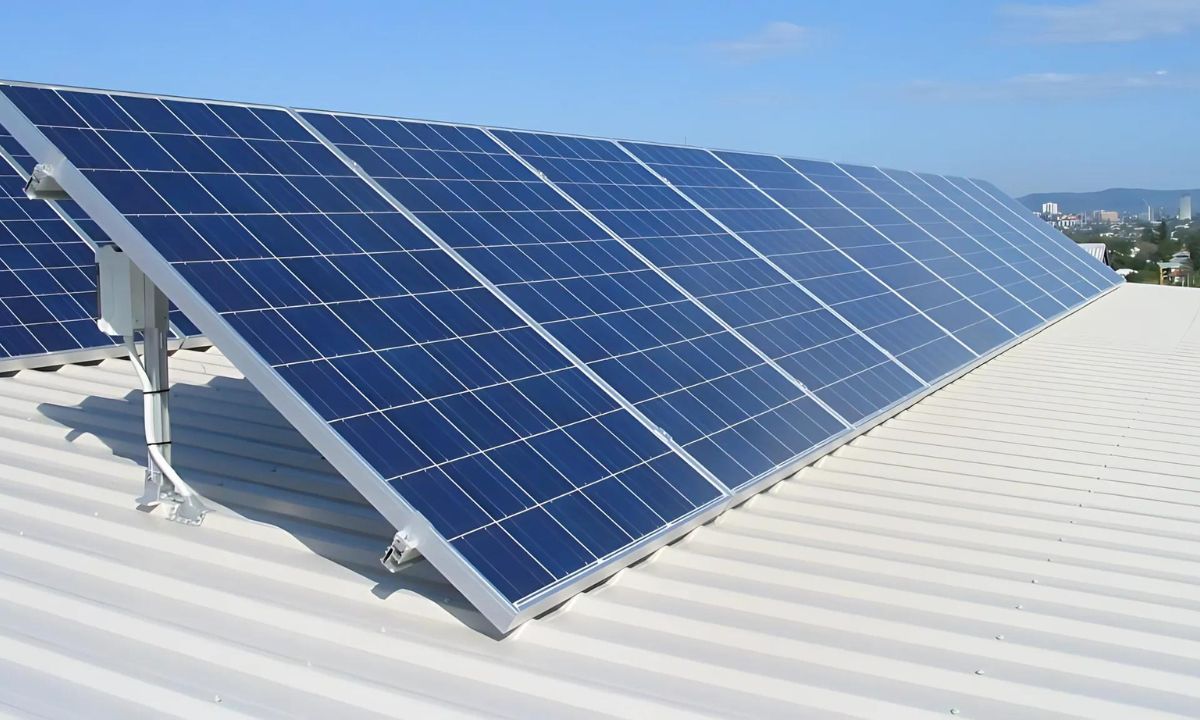Imagine a world where your smartphone not only displays vivid, lifelike images but also harvests energy from the very light that illuminates its screen. This isn’t science fiction—it’s the promise of XCV Panel technology.
As we stand on the brink of a revolution in both energy management and display technology, XCV Panels are emerging as a game-changer that could reshape our interaction with devices and our approach to sustainable power.
In an era where efficient energy management and high-quality displays are more crucial than ever, XCV Panels offer a unique solution that marries these two seemingly disparate fields.
By leveraging cutting-edge solar technology and advanced display innovations, XCV Panels are poised to transform everything from our personal devices to large-scale energy systems.
TL;DR
XCV Panels are an innovative technology that combines advanced display capabilities with solar energy harvesting. They use perovskite materials to create efficient, vibrant screens that can also generate power from ambient light. This dual functionality makes them ideal for smartphones, tablets, and other devices, potentially extending battery life while providing superior visual experiences. XCV Panels also have applications in building-integrated photovoltaics and could play a significant role in future sustainable energy solutions.
What is an XCV Panel?
An XCV Panel, short for Extended Color Vision Panel, is a groundbreaking technology that integrates high-performance display capabilities with efficient solar energy conversion. At its core, an XCV Panel is a multi-layered structure that serves two primary functions:
- Display Technology: XCV Panels utilize advanced color reproduction techniques to deliver vibrant, high-resolution visuals with an extended color range.
- Solar Technology: Simultaneously, these panels incorporate photovoltaic systems that can convert light—both natural and artificial—into usable electricity.
The key to XCV Panel’s dual functionality lies in its innovative use of perovskite materials. These light-absorbing compounds have revolutionized the field of solar technology, offering high efficiency in a thin, flexible format. When integrated into display panels, perovskites enable:
- Enhanced visuals with a broader color spectrum
- Improved energy efficiency in display operation
- The ability to harvest light energy, even in low-light conditions
Here’s a breakdown of the key components in an XCV Panel:
| Component | Function |
| Perovskite Layer | Light absorption and conversion |
| Color Filter Array | Color separation and enhancement |
| Transparent Electrode | Electrical conductivity |
| Backplane | Pixel control and power management |
| Encapsulation Layer | Protection from environmental factors |
XCV Panels differ from traditional energy management systems and display technologies in several ways:
- Dual Functionality: Unlike conventional solar panels or displays, XCV Panels serve both purposes simultaneously.
- Efficiency: They offer higher energy conversion efficiency compared to many traditional solar technologies.
- Versatility: XCV Panels can be integrated into a wide range of devices and structures, from smartphones to building facades.
- Color Accuracy: The extended color vision capabilities provide more accurate and vibrant color reproduction than many standard displays.
As we delve deeper into how XCV Panels work, we’ll uncover the intricate processes that make this technology a potential game-changer in both the energy and display sectors.
How do XCV Panels work?
The operation of XCV Panels is a marvel of modern engineering, combining principles from both solar technology and advanced display systems. Let’s break down the process step-by-step:
- Light Absorption: When light hits the XCV Panel, the perovskite layer absorbs photons across a wide spectrum of wavelengths.
- Electron Excitation: The absorbed light causes electrons in the perovskite material to become excited and move to a higher energy state.
- Charge Separation: These excited electrons are separated from the “holes” they leave behind, creating an electric field.
- Energy Conversion: The separated charges are collected at the electrodes, generating an electric current that can be used to power the device or stored for later use.
- Display Function: Simultaneously, the panel’s display elements use a portion of this energy to create vibrant images through controlled light emission.
- Color Processing: The extended color vision technology processes and enhances the color output, resulting in a wider color gamut and more accurate color reproduction.
- Real-time Adjustment: Advanced algorithms continuously optimize the balance between energy harvesting and display performance based on ambient light conditions and user preferences.
The integration with smart building systems takes this a step further:
- Data Collection: XCV Panels can collect data on light levels, energy production, and consumption patterns.
- AI Analysis: Machine learning algorithms analyze this data to predict energy needs and optimize panel performance.
- Automated Control: The system can automatically adjust building systems (like HVAC and lighting) based on the energy available from the XCV Panels.
“XCV Panels represent a quantum leap in how we think about displays and energy harvesting. By combining these functions, we’re not just improving efficiency—we’re creating entirely new possibilities for sustainable technology.” – Dr. Emma Chen, Lead Researcher at SolarTech Institute
The role of AI and machine learning in XCV Panel functionality cannot be overstated. These technologies enable:
- Predictive maintenance to prevent system failures
- Dynamic adjustment of color output based on ambient light conditions
- Optimization of energy storage and distribution within a smart grid system
By seamlessly blending solar technology with display panels, XCV Panels are pushing the boundaries of what’s possible in energy conversion and visual quality.
Applications of XCV Panels
The versatility of XCV Panels opens up a wide range of applications across various sectors. Here’s an in-depth look at how this technology is being implemented:
Residential Use
In homes, XCV Panels are revolutionizing both energy management and entertainment systems:
- Smart Windows: XCV Panels can be integrated into window panes, serving as both a source of natural light and a power generator.
- Home Entertainment: Television and gaming displays equipped with XCV technology offer superior visual quality while reducing energy consumption.
- Smart Home Devices: From thermostats to security cameras, XCV Panels can power various IoT devices throughout the home.
Commercial Building Applications
The commercial sector is perhaps where XCV Panels shine brightest:
- Office Spaces: Large display walls double as power sources, reducing a building’s reliance on the grid.
- Retail Environments: Digital signage and product displays become self-powered, offering vivid visuals without increasing energy costs.
- Data Centers: XCV Panels can help offset the massive energy demands of server farms while providing high-quality display outputs for monitoring systems.
Industrial Implementations
In industrial settings, XCV Panels are finding innovative uses:
- Factory Floors: Machine interfaces equipped with XCV technology provide clear visuals in harsh environments while contributing to the facility’s power needs.
- Warehouses: Large-scale implementation of XCV Panels in skylights and walls can significantly reduce lighting and heating costs.
- Agricultural Facilities: Greenhouse coverings with XCV technology can help optimize light for plant growth while generating power for other operations.
Smart City Integration
As urban areas evolve, XCV Panels are becoming integral to smart city infrastructure:
- Public Transportation: Bus stops and train stations use XCV Panels for real-time information displays that are self-powered.
- Street Lighting: Smart streetlights with XCV technology adjust brightness based on ambient conditions while storing excess energy for nighttime use.
- Emergency Services: Portable XCV Panels provide reliable power and communication displays in disaster response scenarios.
Potential Future Applications
The future of XCV Panels holds even more exciting possibilities:
- Wearable Technology: Imagine smartwatches and AR glasses with vibrant, energy-generating displays.
- Automotive Industry: Car windows and dashboards could incorporate XCV technology, enhancing both aesthetics and energy efficiency.
- Space Exploration: XCV Panels could be crucial for powering and displaying information in future space habitats.
Advantages of XCV Panels
The benefits of XCV Panels extend far beyond their dual functionality. Let’s explore the myriad advantages this technology offers:
1. Energy Efficiency Improvements
XCV Panels represent a significant leap in energy efficiency:
- Dual-use efficiency: By combining display and energy harvesting functions, XCV Panels eliminate the need for separate systems, reducing overall energy consumption.
- High conversion rates: Advanced perovskite materials used in XCV Panels can achieve higher solar conversion efficiencies compared to traditional silicon-based solar cells.
- Low-light performance: Unlike conventional solar panels, XCV technology can generate power even in low-light conditions, making it effective for indoor use.
2. Cost Savings for Users
The economic benefits of XCV Panels are substantial:
- Reduced energy bills: By generating their own power, devices and buildings equipped with XCV Panels can significantly lower electricity costs.
- Lower installation costs: The integration of display and power generation functions means fewer separate systems to install and maintain.
- Extended device lifespan: The self-powering nature of XCV Panels can reduce battery wear in portable devices, potentially extending their usable life.
3. Environmental Benefits
XCV Panels contribute to a greener future:
- Reduced carbon footprint: By harnessing solar energy, XCV Panels decrease reliance on fossil fuel-based power sources.
- Material efficiency: The dual functionality means less raw material is needed compared to separate display and solar panel production.
- E-waste reduction: Longer-lasting devices powered by XCV technology could help reduce electronic waste.
4. Enhanced Building Performance and Comfort
In architectural applications, XCV Panels offer unique advantages:
- Dynamic shading: XCV Panels in windows can adjust their opacity, optimizing natural light and temperature control.
- Improved aesthetics: Unlike traditional solar panels, XCV technology can be seamlessly integrated into building designs.
- Acoustic benefits: The multi-layered structure of XCV Panels can provide additional sound insulation when used in building envelopes.
5. Ease of Use and Management
XCV Panels are designed with user-friendliness in mind:
- Intuitive interfaces: Devices with XCV displays can provide real-time energy production and consumption data.
- Seamless integration: XCV Panels can easily connect with existing smart home and building management systems.
- Low maintenance: The solid-state nature of XCV technology means fewer moving parts and potentially lower maintenance requirements.
6. Scalability and Adaptability
The versatility of XCV Panels makes them highly scalable:
- Size flexibility: XCV technology can be applied to surfaces ranging from small wearable devices to large building facades.
- Customization options: The color and transparency of XCV Panels can be adjusted to suit various aesthetic requirements.
- Upgrade potential: The modular nature of many XCV Panel installations allows for easy upgrades as the technology advances.
By offering these diverse advantages, XCV Panels are not just an incremental improvement in display or solar technology—they represent a paradigm shift in how we think about energy generation and visual interfaces in our daily lives.
Market Growth and Future of XCV Panels
The XCV Panel market is poised for explosive growth, driven by increasing demand for energy-efficient technologies and superior display quality. Let’s dive into the current market landscape and future projections:
Current Market Size and Projections
The global market for XCV Panels is still in its early stages but is expected to grow rapidly:
- 2023 Market Size: Estimated at $2.5 billion
- Projected CAGR: 25% from 2024 to 2030
- 2030 Projected Market Size: $15.7 billion
This growth is fueled by several factors:
- Increasing adoption in consumer electronics
- Growing demand for sustainable building materials
- Government initiatives promoting green technologies
Key Players in the XCV Panel Industry
Several companies are at the forefront of XCV Panel development:
- SolarVision Tech: Pioneers in perovskite-based display technology
- EcoScreen Innovations: Leaders in large-scale XCV Panel applications for architecture
- QuantumLight Solutions: Specializing in XCV Panels for portable devices
- GreenDisplay Corp: Focusing on industrial and commercial XCV Panel systems
- NanoSolar Dynamics: Pushing the boundaries of XCV Panel efficiency through nanotechnology
Emerging Trends in XCV Panel Technology
The field of XCV Panels is rapidly evolving, with several exciting trends on the horizon:
- Increased Efficiency: Researchers are working on pushing the combined energy conversion and display efficiency of XCV Panels beyond 30%.
- Flexible and Transparent Panels: Development of highly flexible and fully transparent XCV Panels for seamless integration into various surfaces.
- Self-Healing Materials: Incorporation of self-healing polymers to extend the lifespan of XCV Panels.
- AI Integration: Advanced AI algorithms for real-time optimization of energy harvesting and display performance.
- Quantum Dot Enhancement: Utilization of quantum dot technology to further improve color accuracy and energy efficiency.
Potential Challenges and Solutions
Despite the promising outlook, the XCV Panel industry faces some challenges:
| Challenge | Potential Solution |
| High initial costs | Economies of scale and government incentives |
| Durability concerns | Advanced encapsulation techniques and self-healing materials |
| Recycling complexity | Development of specialized recycling processes for XCV Panels |
| Standardization issues | Industry-wide collaboration to establish common standards |
Impact of Government Regulations and Incentives
Government policies play a crucial role in shaping the future of XCV Panels:
- Tax Credits: Many countries offer tax incentives for buildings incorporating energy-generating technologies like XCV Panels.
- Building Codes: Updated regulations are beginning to favor integrated solar solutions in new constructions.
- Research Funding: Increased government grants for R&D in perovskite and display technologies.
- Emissions Targets: Stricter carbon emission goals are driving adoption of technologies like XCV Panels in both public and private sectors.
“The regulatory landscape is shifting rapidly in favor of technologies like XCV Panels. We’re seeing a perfect storm of environmental necessity, technological readiness, and policy support.” – Sarah Johnson, Energy Policy Analyst
As we look to the future, it’s clear that XCV Panels are not just a passing trend but a fundamental shift in how we approach both display technology and energy generation. The convergence of these fields promises to create more sustainable and visually rich environments in every aspect of our lives.
Conclusion
XCV Panels represent a remarkable convergence of solar technology and display innovation, offering a glimpse into a future where our devices and buildings are not just energy-efficient, but energy-generating. From smartphones with extended battery life to skyscrapers that power themselves, the potential applications of XCV Panels are as vast as they are exciting.
Key takeaways:
- XCV Panels combine high-quality displays with efficient solar energy conversion.
- They offer significant advantages in energy efficiency, cost savings, and environmental sustainability.
- The market for XCV Panels is projected to grow rapidly, driven by technological advancements and increasing demand for sustainable solutions.
- Challenges remain, but ongoing research and supportive policies are paving the way for widespread adoption.
As we stand on the brink of this technological revolution, it’s clear that XCV Panels have the potential to reshape our relationship with energy and visual information.
Whether you’re a consumer looking for more sustainable devices, a business owner aiming to reduce energy costs, or an environmentally conscious individual, XCV Panels offer a compelling vision of a more efficient, vibrant, and sustainable future.
The journey of XCV Panels is just beginning, and the coming years promise even more exciting developments. As this technology continues to evolve, it will undoubtedly play a crucial role in our transition to a more sustainable and visually rich world.
FAQ’s
Does solar panel voltage have to match battery voltage?
No, solar panel voltage doesn’t have to exactly match battery voltage. It’s often higher to account for voltage drops and to ensure efficient charging. Charge controllers regulate the voltage from panels to batteries.
What is the highest voltage solar panel?
The highest voltage solar panels are typically used in utility-scale installations and can reach up to 1500V DC. For residential use, high-voltage panels might go up to 50-60V under open-circuit conditions.
What is the difference between a solar panel and a solar module?
A solar panel is a single unit containing multiple solar cells, while a solar module is a collection of panels wired together. Modules are often pre-assembled for easier installation in larger systems.
How many volts should a solar panel put out?
Most residential solar panels produce between 18V to 37V under standard test conditions. However, their open-circuit voltage can be higher, typically around 40-50V for a 60-cell panel.
How many types of solar panels are there?
There are three main types of solar panels:
- Monocrystalline
- Polycrystalline
- Thin-film
Each has different efficiency levels, costs, and applications.
How many volts is a house solar panel?
Residential solar panels typically produce around 30-40V DC under standard test conditions. However, systems are often designed to output 240V AC after going through an inverter to match household electrical systems.
What is the output current of a solar panel?
The output current of a solar panel varies depending on its size and efficiency. A typical residential panel might produce 8-10 amps under ideal conditions. However, this can range from 5 to 15 amps for different models.
What is logic panel?
A logic panel, in the context of solar systems, typically refers to a control panel that manages the system’s operations. It might include inverters, charge controllers, and monitoring equipment to optimize the solar array’s performance.
Who is biggest solar panel manufacturer in USA?
As of 2023, First Solar is the largest solar panel manufacturer in the USA. They specialize in thin-film solar modules and have significant production capacity in Ohio.
Also Read : Otelia Cox: All You Need to Know About Tony Cox’s Wife

Taylor Swift is the founder and lead writer behind the independent blog genrealpro.com










